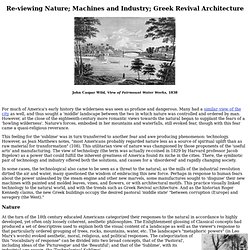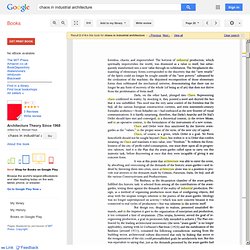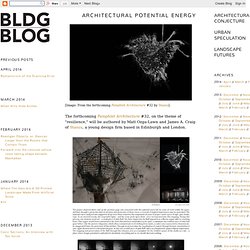

Architecture and Nostalgia in the Age of Ruin (Dylan Trigg) Centre as a place in which force and energy converges, but whether or not this need be the case is another matter.

On the other hand, I want to argue that in our cultureof anxiety and nostalgia, the ruin occupies a privileged role. Far from the discards of society, what I would like to suggest is that ruins crystallise what is essential to ourown time.First, a disclaimer.
Tate Papers - The Photographic Comportment of Bernd and Hilla Becher. Aesthetics%20of%20Decay%20Sample%20Chapter. Epd_ghosts. Tim Edensor - British Industrial Ruins - Introduction. Industrialni.stopy-web. Prumyslove.dedictvi-web. BPSthesis. Crisman_From_industry_to_Culture_JoA_07. Nature, Technology, Architecture. John Caspar Wild, View of Fairmount Water Works, 1838 For much of America's early history the wilderness was seen as profane and dangerous.

Many had a similar view of the city as well, and thus sought a 'middle' landscape between the two in which nature was controlled and ordered by man. However, at the close of the eighteenth-century more romantic views towards the natural began to supplant the fears of a 'howling wilderness'. Nature's forces, embodied in her mountains and waterfalls, still evoked fear, though with this fear came a quasi-religious reverance.
This feeling for the 'sublime' was in turn transferred to another fear and awe producing phenomenon: technology. Dylan Trigg « Interview « ReadySteadyBook - for literature... Dylan Trigg (1978- ), is a research student and tutor in philosophy at the University of Sussex.

He has published on the phenomenology of place, continental philosophy, and aesthetics. He is the author of The Aesthetics of Decay: Nothingness, Nostalgia and the Absence of Reason. His blog is Side Effects. Industry as Icon: Industrial Aesthetics, An article and some photos by Murat Germen. Design, by its own nature, strives to be “different”, it gives a certain object its identity by “transforming” it and excluding others.

Fashion, industry, architecture and graphic design always seek the new and they actually should in any case, in order to continue their existence. Furthermore, there have been / will always be, creative processes where function takes precedence, forms are created in response to needs. Despite the fact that functional design processes and resulting end products are usually regarded as obstacles to a freer creativity, they are “designs” anyhow. The fact that the starting point is different should not necessarily prevent us from perceiving a functional production process / product as “design.”
Architecture theory since 1968. Books.google.co.uk - In the discussion of architecture, there is a prevailing sentiment that, since 1968, cultural production in its traditional sense can no longer be understood to rise spontaneously, as a matter of social course, but must now be constructed through ever more self-conscious theoretical procedures.

The development... Theory Since 1968 Page 19. Chance's Glassworks, Machine Workshop, Spon Lane South, Smethwick, West Midlands BL25035_001. Rhetoric of machine aesthetics. Brummett addresses the question of how the aesthetic experience of machines can have rhetorical influence.

Aesthetics%20of%20Decay%20Sample%20Chapter. City. The aesthetics of decay: nothingness ... The aesthetics of architecture. Architectural Potential Energy. [Image: From the forthcoming Pamphlet Architecture #32 by Stasus].

The forthcoming Pamphlet Architecture #32, on the theme of "resilience," will be authored by Matt Ozga-Lawn and James A. Craig of Stasus, a young design firm based in Edinburgh and London. [Images: From the forthcoming Pamphlet Architecture #32 by Stasus]. The pamphlet, which will explore a series of post-industrial sites in the city of Warsaw—"a desolate area of disused freight rail tracks, commercial lots, gasometer buildings and other industrial apparatus," as the architects describe it—is more explicitly narrative than the other pamphlets that have been most recently published. "The scope and intent of our book," Stasus writes, citing such influences as Piranesi and Andrei Tarkovsky's film Stalker, "is to highlight the importance of forgotten landscapes in our cities and the potentialities that can be extracted from them.
" Industrial ruins: spaces, aesthetics ... Holgate. Aesthetics of built form: Chapter 8. Iakov Chernikhov’s The Construction of Architectural and Machine Forms (1932) « Modernist Architecture. In publishing this work by architect Iakov G.

Chernikhov, the Leningrad Society of Architects considers that the theme treated by the author is extremely interesting and timely, although it is not entirely in agreement with the method and character of his exposition. The question of designing [oformlenie] any sort of object, i.e. of giving it a form which corresponds to its functional purpose and its material, is a basic component of his creative work for any architect, and has a practical interest as well as a philosophical one.
In a sense the graphic representations which reinforce the author’s thoughts here form the centre of gravity of the whole book. 29 July 1930 To All. InfrastructureAsArchitecture. Industry as Icon: Industrial Aesthetics, An article and some photos by Murat Germen.